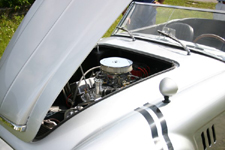Early life
Born in Perranporth, Cornwall, elder son of Frederick (John Frederick) and Emma Healey (Mitchell) who at that time ran a general store there, Donald Healey became interested in all things mechanical at an early age, most particularly aircraft. He studied engineering while at Newquay College. When he left his father bought him an expensive apprenticeship with Sopwith Aviation Company in Kingston upon Thames, Surrey and he joined Sopwith in 1914 continuing his engineering studies at Kingston Technical College. Sopwith had sheds at the nearby Brooklands aerodrome and racing circuit. Barely 16 when WW1 started, he volunteered in 1916 (before the end of his apprenticeship) for the Royal Flying Corps (RFC) and earned his "wings" as a pilot. He went on night bombing raids and served on anti-Zeppelin patrols and also as a flying instructor. Shot down by British anti-aircraft fire on one of the first night bomber missions of the war, after a further series of crashes he was invalided out of the RFC in November 1917 and spent the rest of the war checking aircraft components for the Air Ministry. After the Armistice he returned to Cornwall, took a correspondence course in automobile engineering and opened the first garage in Perranporth in 1920.
Healey found rally driving and motor racing more interesting than his garage and its car hire business and used the garage to prepare cars for competition. He first entered the Monte Carlo Rally in 1929 driving a Triumph 7 but in 1931 Donald Healey won the Monte Carlo Rally driving a 4.5-litre Invicta and was 2nd overall the next year. Now in demand as a competition driver he sold the garage business, moved to the Midlands to work for Riley but soon moved to the Triumph Motor Company as experimental manager. The next year he was made technical director and responsible for the design of all Triumph cars. He created the Triumph Southern Cross and then the Triumph Dolomite 8 straight-eight sports car in 1935 following his class win, and 3rd overall, in the 1934 Monte Carlo
Rally in a Triumph Gloria of his own design, the previous year a train demolished their Dolomite on a foggy level crossing miraculously saving Healey and his co-driver. Triumph went into liquidation in 1939 but Healey remained on the premises as works manager for H M Hobson making aircraft engine carburettors for the Ministry of Supply. Later in the war he worked with Humber on armoured cars. Donald Healey was keen to begin making his own cars, planning post-war sports cars with colleague and chassis specialist Achille Sampietro.
Healey then formed a design consultancy in 1955, one of the results was the Austin-Healey Sprite which went into production in 1958. The production arrangement with BMC ended in 1967.
In 1970 Healey became chairman of Jensen Motors with the enthusiastic backing of key US based Austin-Healey distributors. This was a long and fruitful relationship for Healey, in part because Jensen had been making body shells for Austin-Healey since the 1952 demise of the similar Austin A40 Sports. Healey's first project with a Jensen was re-engineering the Jensen 541S with a V8 engine in 1961, the resulting car being a personal favourite of Healey's.
Ten years later, Healey helped design the Lotus engined Jensen-Healey together with Lagonda designer William Towns, to replace the Austin-Healey, which BMC were discontinuing. He designed this new Jensen-Healey using Vauxhall components but it was unable to comply with the emission standards set in place in USA. He resisted offers from Saab and Ford to produce a new sports car.
Retiring from automobile manufacturing, he bought the 27 acre (11 ha) Trebah Estate, near Falmouth, Cornwall in 1961 and carried out many ambitious projects there, including the building of commercial greenhouses to grow orchids and a project to build air/sea rescue inflatables. He demolished the concrete covering of the beach of Polgwidden Cove (a D-Day invasion launch-pad) and used the salvaged material to surface a steep track from the house to the beach. He sold Trebah in 1971. His son, Geoffrey, born in 1922 and a former pupil of Warwick School, wrote several books about the cars and one about their partnership.
Donald Healey died in Truro at the age of 89. A memorial window in St Michael's Church Perranporth was provided by the Austin-Healey Club of America. The Austin Healey Club has also placed a small monument, in the form of a sports car, and an inscribed plaque, as a memorial to Donald Healey, next to the Visitor Centre in the garden of Trebah which is now open to the public.
His obituary in The Times reported that Healey was a small rotund man with a flashing smile and that he kept himself immensely fit, and had been, in his day, an expert water skier.
